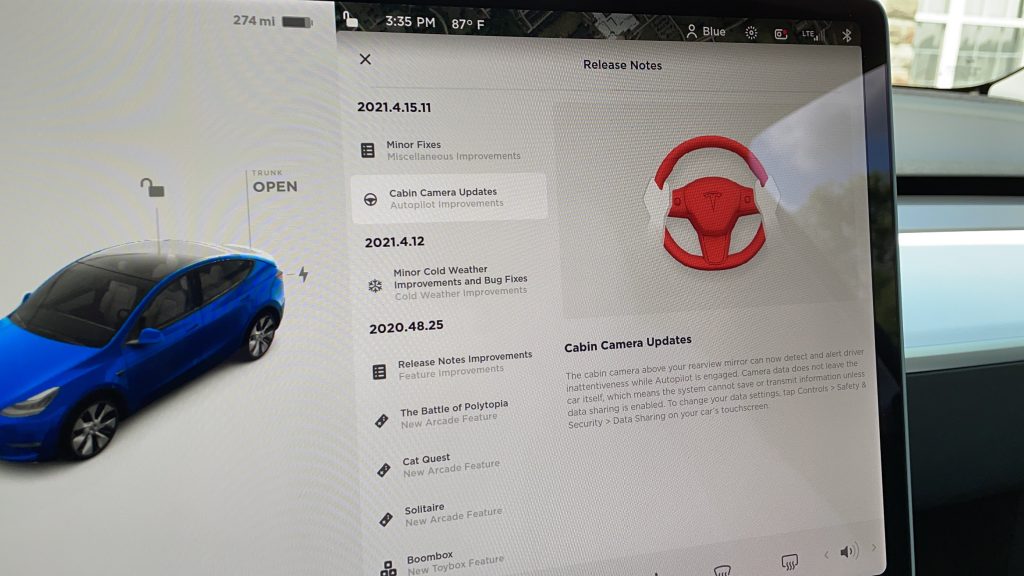
It looks like Tesla will finally add driver monitoring, with new images of the release notes from software update 2021.4.15.11. After having months of just bug fixes and cold weather improvements, if you get this build, there’s a new item call ‘Cabin Camera Updates’.
The release notes read:
The cabin camera above your rearview mirror can now detect and alert driver inattentiveness while Autopilot is engaged. Camera data does not leave the car itself, which means the system cannot save or transmit information unless data sharing is enabled. To change your data settings, tap Controls > Safety & Security > Data Sharing on your car’s touchscreen.
Ok so why would Tesla want to or need to enable the cabin camera? Since first delivering the cabin camera in the Model 3, then the Model Y, Tesla has said the cabin camera would be used to monitor passengers during eventual robotaxi rides, much like security cameras in taxis work today. So far, they’ve been disabled, unless you’re part of the FSD beta program.
Tesla has monitored inattentiveness to date by using a progressive nag, that first asks you to feed input to the steering wheel to let the car know know you’re paying attention. This occurs every 30 seconds or so, depending at what speed you’re travelling and we’ve seen Tesla experiment with this duration over previous software updates.
With the internal cabin camera, located just above the rearview mirror, it’s possible for Tesla to use this for driver monitoring, ensuring the driver is not asleep or on their phone. While Musk seemed to resist this idea during a Lex Fridman interview a couple years ago, that was of the understanding that FSD would be here by now and wouldn’t require a driver at all. Given the delays in delivering FSD, it seems driver monitoring using the cabin camera would be a good step forward to remote the nag, which feels particularly old-school on long, highway drives with well-marked roads.
To some, it may have seemed like the hands-off driving offered by GM’s SuperCruise and soon Ford’s BlueCruise, was actually more advanced than Tesla’s Autopilot. Although those systems are severely limited by location, when you can use them, it was a better experience than having to touch the wheel every ~30 seconds.
Hopefully this new update is the runway to Tesla offering hands-free driving and then we have the issue of potential retro-fits for Model S and X owners that don’t have a cabin camera.
The update was shared by a new Model Y owner, Kevin Smith (@spleck)
While the the camera is small, we can see from this video by GreenTheOnly, that it does indeed have enough resolution (and brightness at night) to determine the driver’s behaviour. While Tesla may have added additional states, back in April, the software contains monitoring for the following driver states including Driver eyes down, Phone use, Driver Head down, Driver Eyes Closed and even tackled the challenge of those wearing sunglasses.
Asked if this build removed the nag, Smith confirmed it does not and suggests the change could come after an initial validation period. I agree with this, it’s likely Tesla run a comparison in shadow mode, enabling them to determine the accuracy of driver monitoring using Computer Vision, versus the inputs they get through the torque sensor in the wheel.
There will be a day where these cars can drive themselves, but until then, driver monitoring just makes sense.
Let’s hope Tesla rolls out hands-free driving soon and I for one, would enable it in a heartbeat to replace the steering wheel nag.
